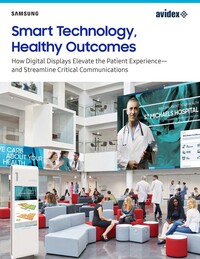3 min read
Transforming Learning: How Audiovisual Solutions Are Creating Flexible Classrooms — and Saving Schools Money
![]() Michael Stammire
Jun 9, 2025 12:01:31 PM
Michael Stammire
Jun 9, 2025 12:01:31 PM

Education is changing fast and flexibility isn’t just a nice-to-have anymore, it’s essential. As teaching methods evolve and student needs grow more diverse, schools and universities are rethinking what learning spaces should look like.
That’s where audiovisual (AV) technology comes in. Today’s AV tools do more than improve how things look and sound — they’re helping to transform classrooms into dynamic, adaptable spaces that put students first while staying budget-friendly.
Let’s take a look at some of the AV solutions that are making a real impact — supporting teachers, engaging students, and creating long-term value.
technology solutions for education
Campuses looking to create a flexible learning environment should explore these options:
-
Wireless Document Cameras: Learning Without Limits
Gone are the days of being tethered to a desk or podium. Wireless document cameras give educators the freedom to move around the room while still displaying content to the class. Whether showcasing a student’s project or conducting a science demo, these tools promote active engagement and collaboration.
They also reduce the need for expensive overhead projectors or multiple static setups, keeping classrooms streamlined and cost-efficient.
-
Mobile Interactive Whiteboards: Collaboration in Motion
Mobile interactive whiteboards can be easily reconfigured for different classroom layouts. Whether facilitating group work, individual instruction, or whole-class discussions, these tools adapt with ease.
Their mobility also means one device can serve multiple classrooms or learning zones, reducing the need to outfit every room with fixed installations.
-
Modern Projectors: Big Ideas, Bigger Impact
Compact laser projectors now offer brilliant image quality with low maintenance. Unlike older bulb projectors, laser models last longer and require fewer replacements. This not only cuts down on maintenance costs, but also supports flexible classroom layouts where portable projection is more practical than fixed displays.
-
Networked AV Systems: The Power of Seamless Sharing
Networked AV systems let schools centralize content delivery and distribute it efficiently across multiple classrooms using existing network infrastructure. This reduces the need for duplicate hardware in each room and simplifies management and upgrades.
With centralized control, IT departments spend less time troubleshooting, and hardware investments stretch further.
-
Interactive Touch Screens: Hands-On Learning Reimagined
Touch-enabled displays support diverse learning styles and real-time collaboration. By replacing whiteboards, projectors, and even some computing equipment, these all-in-one solutions reduce the need for multiple devices.
Over time, this consolidation of tools leads to lower hardware costs and fewer compatibility issues.
-
Integrated AV Control Systems: Simplicity That Saves
Integrated control systems allow teachers to manage all classroom AV tech from a single interface. This user-friendly approach reduces training time and eliminates costly errors or misuse.
Systems with built-in automation — like motion sensors and smart scheduling — also help reduce energy costs by ensuring lights and devices only operate when needed.
-
Accessible by Design: Supporting Every Learner
AV solutions with built-in accessibility features (like live captions, screen readers, and audio amplification) ensure inclusive learning without requiring additional, separate investments in assistive tech for each need.
By planning inclusivity into the AV infrastructure from the start, schools avoid the high costs of retrofitting later.
Why Flexible av infrastructure pays off
While the upfront investment in AV technology may seem high, its long-term value lies in its flexibility. Here’s how it adds up:
- Reduced equipment redundancy: Mobile and multi-use AV tools serve multiple purposes and classrooms.
- Lower maintenance and energy costs: Newer technologies are more efficient and durable.
- Fewer replacements: Long-life projectors, networked systems, and cloud-based tools reduce frequent hardware refreshes.
- Improved IT efficiency: Centralized control and streamlined support cut down on tech-related downtime and staffing needs.
- Scalable design: Schools can start small and expand as needed — no need for complete overhaul.
Flexible AV infrastructure isn’t just smart for learning — it’s smart for budgets.
Get Started with Avidex
Ready to future-proof your classrooms while saving on long-term costs? Avidex is the trusted partner schools and universities rely on to design and implement flexible, future-ready AV solutions. From mobile whiteboards to networked systems and accessible tech, Avidex delivers the tools that make learning more dynamic, inclusive, and cost-effective. With our expertise, your AV investment goes further — reducing redundancies, cutting maintenance costs, and empowering teachers with simple, scalable technology. Don’t just upgrade your classrooms — transform them. Partner with Avidex and make smart AV work for your school today.

About the Author
Michael Stammire brings over two decades of audiovisual and technology experience to his position as General Manager of the Avidex Southern California branch. He started his career at Digital Networks Group in 2001, which Avidex acquired in 2016. Before becoming General Manager, as VP of Procurement, he and his team launched the Avidex Strategic Partner program to build alliances with key partners, bolster sales for Avidex and our vendors, and improve our supply chain efficiency. Michael holds a business degree from Cal State Fullerton and an MBA from the University of Notre Dame.


